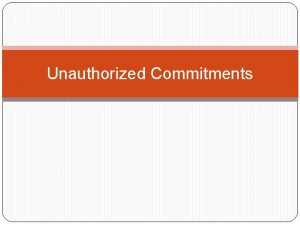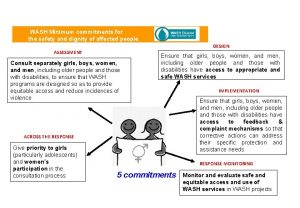WASH Minimum commitments for the safety and dignity


- Slides: 2

WASH Minimum commitments for the safety and dignity of affected people DESIGN ASSESSMENT Consult separately girls, boys, women, and men, including older people and those with disabilities, to ensure that WASH programs are designed so as to provide equitable access and reduce incidences of violence Ensure that girls, boys, women, and men, including older people and those with disabilities have access to appropriate and safe WASH services ACROSS THE RESPONSE Give priority to girls (particularly adolescents) and women’s participation in the consultation process IMPLEMENTATION Ensure that girls, boys, women, and men, including older people and those with disabilities have access to feedback & complaint mechanisms so that corrective actions can address their specific protection and assistance needs RESPONSE MONITORING 5 commitments Monitor and evaluate safe and equitable access and use of WASH services in WASH projects

WASH Minimum commitments for the safety and dignity of affected people 5 commitments ASSESSMENT Consult separately girls, boys, women, and men, including older people and those with disabilities, to ensure that WASH programs are designed so as to provide equitable access and reduce incidences of violence DESIGN Ensure that girls, boys, women, and men, including older people and those with disabilities have access to appropriate and safe WASH services IMPLEMENTATION Ensure that girls, boys, women, and men, including older people and those with disabilities have access to feedback & complaint mechanisms so that corrective actions can address their specific protection and assistance needs RESPONSE MONITORING Monitor and evaluate safe and equitable access and use of WASH services in WASH projects ACROSS THE RESPONSE Give priority to girls (particularly adolescents) and women’s participation in the consultation process Outputs v WASH assessments include identification of specific needs of girls, boys, women, including older people and persons with disability in terms of safety, dignity and equitable access v Location of WASH facilities and their design are determined through separate consultations of girls, boys, women, including older people and persons with disabilities in order to ensure equitable access and minimize risks of violence v WASH facilities are designed to respond to distinct dignity, safety and access needs (i. e. all public latrines and shower blocks are separated by sex, locks on the inside, privacy screens considered, lights, pictograms, specific design for people with disability…). This includes WASH facilities in spaces dedicated to children. v Menstrual hygiene needs of girls and women are met v WASH users (girls, boys, women, including elders and persons with disability) are informed of their rights and understand the feedback complaint mechanisms related to WASH programs v The cluster member organisations and coordination platforms set up a feedback mechanism with and for beneficiaries and take timely corrective actions to address safety, dignity and access issues raised by users and/or to redefine their assistance v Baselines and M&E tools include the collection of sex and age disaggregated data on the access and use of WASH facilities, including on how safe people feel using WASH facilities v Collection and analysis of disaggregated data on beneficiaries and information on older people and persons with disability contributes to improving safe and equitable access and use of WASH services for vulnerable population v Specific focus group discussions are organized for women and girls during the needs assessment phase and across the response



